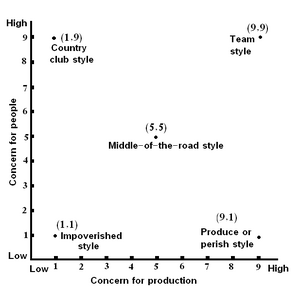Assessment |
Biopsychology |
Comparative |
Cognitive |
Developmental |
Language |
Individual differences |
Personality |
Philosophy |
Social |
Methods |
Statistics |
Clinical |
Educational |
Industrial |
Professional items |
World psychology |
Industrial & Organisational : Introduction : Personnel : Organizational psychology : Occupations: Work environment: Index : Outline
The Managerial Grid Model (1964) is a behavioral leadership model developed by Robert Blake and Jane Mouton. This model identifies five different leadership styles based on the concern for people and the concern for production. The optimal leadership style in this model is based on Theory Y.

A graphical representation of the Managerial Grid
As shown in the figure, the model is represented as a grid with concern for production as the X-axis and concern for people as the Y-axis; each axis ranges from 1 (Low) to 9 (High). The five resulting leadership styles are as follows:
The impoverished style (1,1)[]
In this style, managers have low concern for both people and production. Managers use this style to avoid getting into trouble. The main concern for the manager is not to be held responsible for any mistakes, which results in less innovative decisions.
The country club style (1,9)[]
This style has a high concern for people and a low concern for production. Managers using this style pay much attention to the security and comfort of the employees, in hopes that this would increase performance. The resulting atmosphere is usually friendly, but not necessarily productive.
The produce or perish style (9,1)[]
With a high concern for production, and a low concern for people, managers using this style find employee needs unimportant; they provide their employees with money and expect performance back. Managers using this style also pressure their employees through rules and punishments to achieve the company goals. This dictatorial style is based on Theory X, and is commonly applied by companies on the edge of real or perceived failure.
The middle-of-the-road style (5,5)[]
Managers using this style try to balance between company goals and workers' needs. By giving some concern to both people and production, managers who use this style hope to achieve acceptable performance.
The team style (9,9)[]
In this style, high concern is paid both to people and production. As suggested by the propositions of Theory Y, managers choosing to use this style encourage teamwork and commitment among employees. This method relies heavily on making employees feel as a constructive part of the company.
See also[]
| This page uses Creative Commons Licensed content from Wikipedia (view authors). |